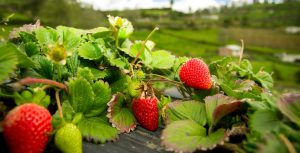
By Kristen James
RED AND PURPLE berries ripening in vast fields. The sun shining in a blue sky as workers in broad-brimmed hats pluck the best berries from the strawberry tufts and blackberry vines.
The bucolic scene in Ventura County along the Southern California coast belies the exacting science and sharp business decisions involved in the farming underway here, where many grow for Driscoll’s Berries and water availability can make or break a season.
Driscoll’s and its farmers don’t leave much to chance, having weathered drought conditions through much of this decade. And now they’re working on the next big challenge – implementing the Sustainable Groundwater Management Act (SGMA) and working to recharge the aquifer through a water recycling program.
Among a variety of studies and data collection efforts to inform better farming techniques, Driscoll’s research station located among the fields looks for the best methods for irrigating and careful use of water, with an eye on adapting to climate impacts.
For instance, given the increased evaporation of surface water in a warming climate, some area farmers now use micro sprinklers – tiny, precise sprinklers that deliver water to a part of the plant near its roots to establish transplants. Other farmers are moving berry growing to substrate farming or tabletop planters in controlled settings such as high tunnel greenhouses.
On a recent visit to Driscoll’s research station, I listened as James duBois, senior manager of Global Environmental Impact for Driscoll’s, explained how substrate farming has environmental and water-saving benefits. Substrate farming reduces water needs by 30 percent and often allows for lower pesticide and fertilizer use, he said. I was visiting because Driscoll’s is a member of Ceres’ Connect the Drops campaign, a group of 35 companies that advocate for smart water management policies in California.
Water has long been top-of-mind for Driscoll’s and Ventura County growers. In fact, area farmers established a groundwater management plan for the Oxnard Plain in the early 1990s, long before SGMA was passed in 2014.
Still, during the recent drought that left many farmers in Ventura and around the state with reduced water supplies, they realized the Oxnard basin was still in severe overdraft and more needed to be done. Many in the community, including Driscoll’s and its largest grower in the area, Reiter Affiliated Companies, welcomed SGMA.
“Water management within the Oxnard basin is very complex. This is one of the reasons we supported SGMA,” duBois said, adding that because local users have the most knowledge of a water basin, Driscoll’s and its growers particularly “supported the local control and consensus-building spirit of SGMA.”
With SGMA guidelines, the farmers and communities in the region started on the path to formalize and fortify their groundwater management plan. The Oxnard Plain and Pleasant Valley Agricultural Overliers Group, of which duBois is an advisory member, has developed a draft proposal that calls for allocations based on growers’ historical needs over the past three years, as well as replenishment of the groundwater basin and the development of lower-impact, recycled water supplies. They hope the proposal will be approved by the governing body for SGMA implementation, the Groundwater Sustainability Agency, in the near future.
“We want the allocation to be real and relevant,” duBois said. In accordance with SGMA – and the spirit of sharing in the community – they also hope their groundwater management plan will address the environmental and water scarcity issues that could threaten the way of life in this region.
And the proposed plan allows water districts to enter water transfer and pumping agreements with each other. DuBois estimates there are currently eight to 10 such transfer transactions in the works in Ventura County at any one time, and this could increase under the new proposal.
Beyond Managing Water
The growers realize, however, that allocating and trading finite amounts of water from an overdrafted groundwater basin isn’t going to solve their water shortage problems.
So the Oxnard groundwater management plan integrates groundwater allocation with a plan to develop “new” water resources through recycling water. Oxnard’s water recycling plan was christened the Oxnard Groundwater Recovery Enhancement and Treatment program (GREAT). The system includes tertiary-level wastewater treatment through an advanced water-purification facility and then groundwater injection to help replenish the aquifers.
The GREAT plan calls for making recycled water available for both groundwater replenishment and irrigating agricultural fields. Although the program has had hiccups, farmers are on board and already using this water.
The efforts around management in the Oxnard groundwater basin appear to be shaping up as a very detailed and advanced example of how California’s groundwater sustainability agencies are developing long-term sustainability plans.
Agriculture is a mainstay of the economy here and careful management of water resources through SGMA implementation is key to keeping it this way, while ensuring the needs of the community and environment are maintained.
Other groundwater sustainability agencies could pull ideas and strategies from the Oxnard Basin’s playbook – not only the content in the plan but also the lessons learned on how to reach this stage successfully.


